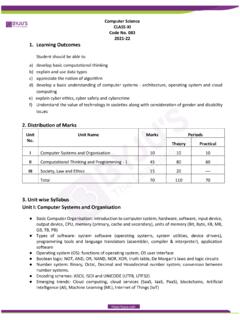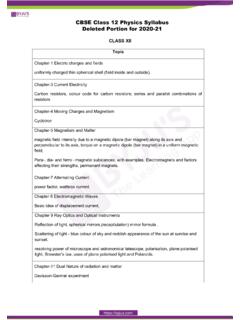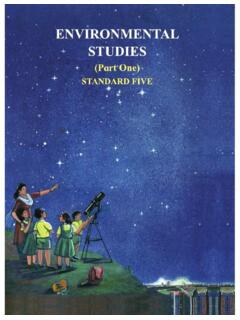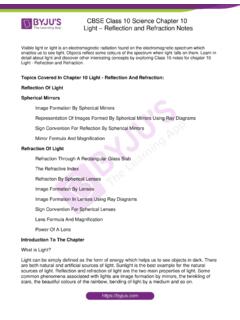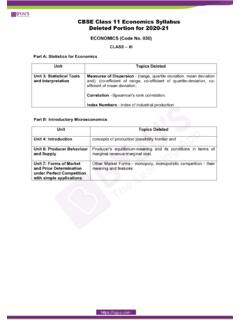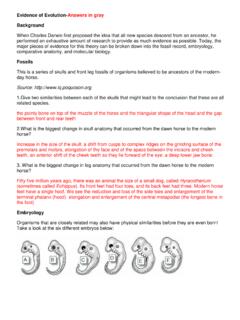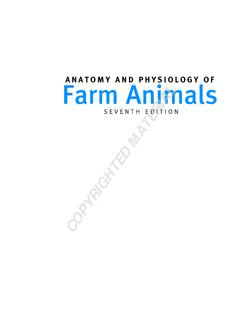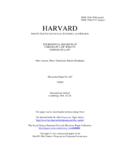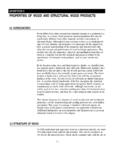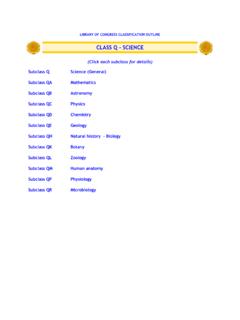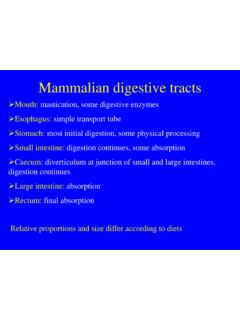Transcription of CBSE Class 11 Biology Deleted Syllabus Portion for 2020-21
1 Biology (Code No. 044) Deleted PORTIONS Class XI Under Unit 1: Diversity of Living OrganismsoChapter-1: The Living World taxonomy and systematics; tools for study of taxonomy- museums, zoological parks, herbaria, botanicalgardens, keys for : Plant Kingdom Angiospermae; Angiosperms - classification up to Class , characteristic featuresand examples. Under Unit-II Structural Organization in Animals and PlantsoChapter-5: Morphology of Flowering Plants Morphology and modifications: Morphology of different parts of flowering plants:root, stem, leaf, fruit and seed. Description of families: - FabaceaeoChapter-6: anatomy of Flowering Plants anatomy and functions of different tissues and tissue systems in dicots andmonocots. Secondary : Structural Organisation in Animals Morphology, anatomy and functions of different systems (digestive, circulatory,respiratory, nervous and reproductive) of an insect (cockroach), (a brief accountonly).
2 Under Unit-IV Plant PhysiologyoChapter-11: Transport in Plants Movement of water, gases and nutrients; cell to cell transport, diffusion,facilitated diffusion, active transport; plant-water relations, imbibition, waterpotential, osmosis, plasmolysis; long distance transport of water - Absorption,apoplast, symplast, transpiration pull, root pressure and guttation; transpiration,opening and closing of stomata; Uptake and translocation of mineral nutrients -Transport of food, phloem transport, mass flow 12: Mineral Nutrition Essential minerals, macro- and micronutrients and their role; deficiencysymptoms; mineral toxicity; elementary idea of hydroponics as a method tostudy mineral nutrition; nitrogen metabolism, nitrogen cycle, biological nitrogenCBSE Class 11 Biology Syllabus Deleted Portion for 2020-21fix ation. o Chapter-15: Plant - Growth and Development Seed germination; phases of plant growth and plant growth rate; conditions of growth; differentiation, dedifferentiation and redifferentiation; sequence of developmental processes in a plant cell; Seed dormancy; vernalisation; photoperiodism Under Unit-V Human Physiology o Chapter-16: Digestion and Absorption Alimentary canal and digestive glands, role of digestive enzymes and gastrointestinal hormones; Peristalsis, digestion, absorption and assimilation of proteins, carbohydrates and fats; calorific values of proteins, carbohydrates and fats; egestion; nutritional and digestive disorders - PEM, indigestion, constipation, vomiting, jaundice, diarrhoea.
3 O Chapter-20: Locomotion and Movement Types of movement - ciliary, flagellar, muscular; Skeletal system and its functions; joints; disorders of muscular and skeletal systems - myasthenia gravis, tetany, muscular dystrophy, arthritis, osteoporosis, gout. Class XI o Chapter-21: Neural Control and Coordination reflex action; sensory perception; sense organs; elementary structure and functions of eye and ear Deleted PORTIONS Class XI: PRACTICAL A: List of Experiments 1. Description of Family Fabaceae; Types of root (Tap and adventitious); types of stem (herbaceous and woody); leaf(arrangement, shape, venation, simple and compound). 2. Preparation and study of of dicot and monocot roots and stems (primary) 3. Study of osmosis by potato osmometer. 4. Study of plasmolysis in epidermal peels ( Rhoeo/lily leaves or flashy scale leaves of onion bulb). 5. comparative study of the rates of transpiration in the upper and lower surface of leaves.
4 6. Test for the presence of sugar, starch, proteins and fats in suitable plant and animal materials. 7. Test for presence of urea in urine. 8. Test for presence of bile salts in urine. B. Study/Observation of the following (spotting) 1. Tissues and diversity in shape and size of plant cells (palisade cells, guard cells, parenchyma, collenchyma, sclerenchyma, xylem and phloem) throughtemporary and permanent slides. 2. Different modifications in roots, stems and leaves. 3. Different types of inflorescence (cymose and racemose). 4. Human skeleton and different types of joints with the help of virtual images/models only.
